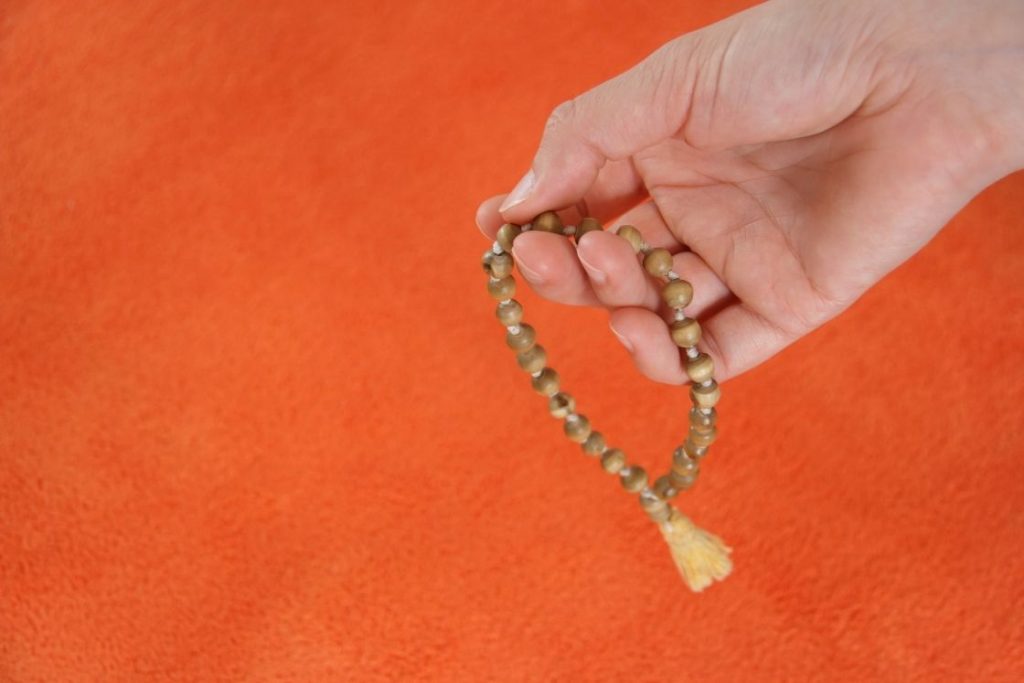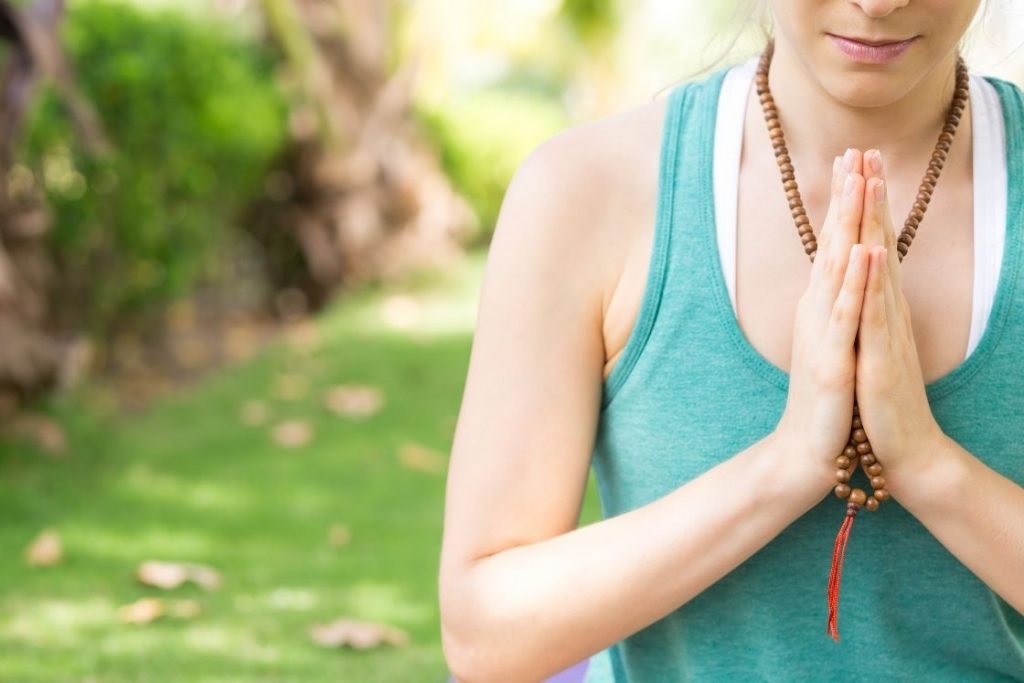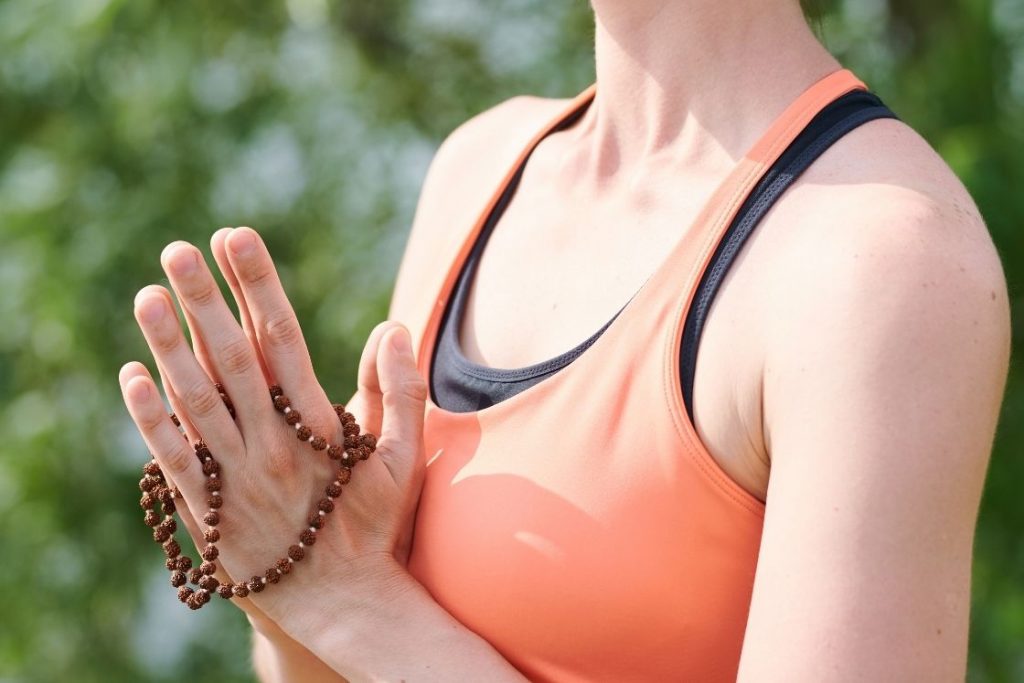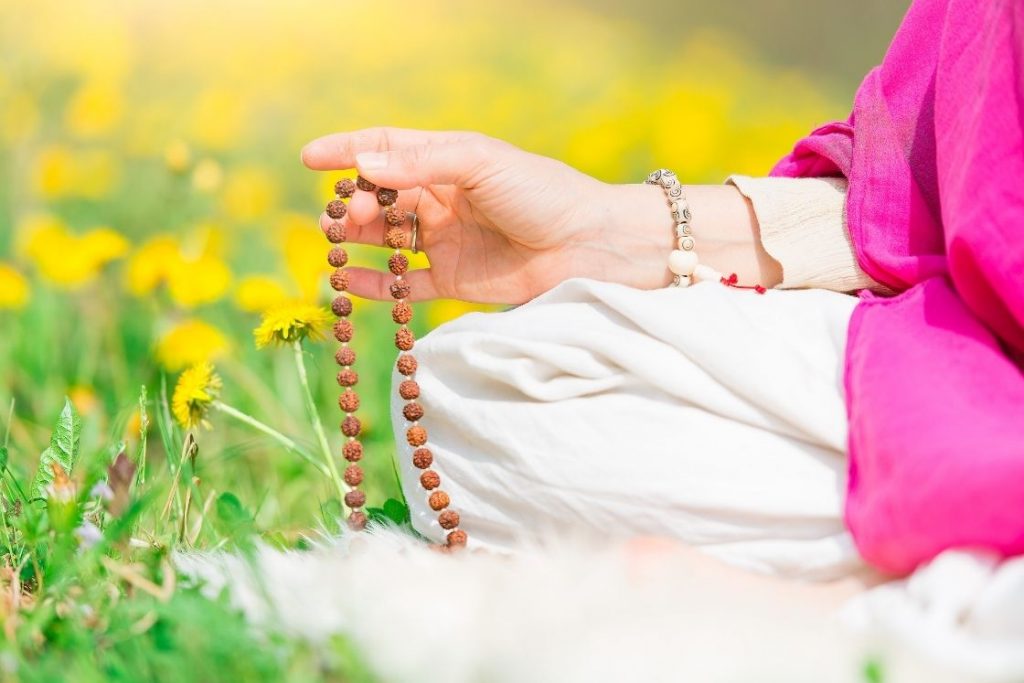
Mantra chanting has been done since ancient times. Not just for rituals but also to achieve inner peace, tranquillity, and connection with the divine. These mantras can be as simple as OM, a phrase such as “OM Shanti, Shanti, Shanti”, a bija mantra such as hreem, shreem, or an entire verse such as the Gayatri Mantra.
In mantra yoga, mantras can be chanted out loudly, softly, silently in the mind, or even while writing. This chanting of mantra is what is essentially known as Japa. If you are chanting a mantra during meditation, it will be called a Japa meditation.
A Japa meditation is mostly done with the help of a Japa mala or garland. The mala is a string that contains beads made from gemstones or crystals that contain special energies. While performing Japa, you count on each bead, which helps you focus on your meditation and chanting.
In this article, we will discuss the meaning of Japa, the significance of using Japa mala, the benefits of performing Japa, and how you can effectively perform Japa meditation.
What is Japa?

Japa is a Sanskrit word that is derived from the root word jap which means “to utter in a low voice, repeat internally, mutter”.
It can also be broken down into ja meaning to destroy the cycle of birth, death and reincarnation and pa meaning to destroy sins of oneself.
In yoga, Japa is considered the practice of repeatedly chanting a beej mantra or specific affirmation to concentrate the mind. The uninterrupted concentration for a longer duration leads to meditation.
A Japa practice is usually done with Japa mala in which the practitioner counts the beads as chanting the mantra. Each bead counting corresponds to one chant of mantra. Normally a Japa mala comes with 108 beads.
Performing Japa will help in removing impure or negative thoughts from the mind, remove or destroy your sins which will ultimately lead to samadhi – the last stage of yoga. During meditation, performing Japa with a mala will help you achieve a higher state of awareness.
It also creates a positive pattern of thoughts that can help you overcome negativity or darkness.
Types of Japa
The inherent definition of Japa tells us that it should be uttered in a low voice, however, you can perform a Japa in varying degrees of loudness.
Vaikhari Japa – When the mantra is chanted out loud so that even others can also hear, it is vaikhari Japa. This type of Japa can come in handy when there are sounds nearby and you are unable to concentrate.
Upamshu Japa – Mantra chanted softly or in a whisper tone is called upamshu Japa. In this type of Japa practice, the lips of the practitioner barely move. Upamshu japa is considered more effective than vaikhari japa.
Manasik Japa – Manasik Japa is when you repeatedly chant the mantra in your mind. It is difficult to chant something in the mind as you need immense focus and concentration and a determination to not get distracted. Also, this type of japa is considered the most powerful when compared to the above two.
There is also another type of Japa where you write the mantra as you speak it out loud or keep silent. This is called likhita Japa. It is a form of Japa meditation where instead of counting on Japa mala beads, you are writing down the mantra for enhanced concentration.
Rules for Practicing Japa
Japa meditation requires you to follow some do’s and don’t so that you can not disrespect the mantra or a tradition unintentionally. It may also lead to adverse effects if not performed correctly.
- Select a quiet and clean place where you will not be disturbed. Keep away any gadgets that may disturb you.
- Do not sit directly on the floor. Place a cloth mat or a yoga mat to prevent loss of energy.
- The best time to practice japa is during Brahma Muhurta. Take a bath or thoroughly wash your face, hands, and feet before sitting down for japa. Other than this, Japa practice can be done at dusk.
- Sit down in a pose that you can sustain for a duration of 1-2 hours. Sukhasana (Easy Pose) is one of the most preferred poses for Japa meditation.
- Pick a mantra that resonates with you the most. Do not pick a mantra if it is too complex to say the words or it is too long.
- If you have been given a mantra by your guru, you can recite them as well. But be cautious that this mantra should not be revealed to anyone.
- Make sure you are holding the japa mala in the right hand. The mala should be looped over the middle finger. The index finger shouldn’t be used at all. Use your thumb to roll the beads.
- The japa mala should never go much below the navel or touch the ground. You can place a hand below the beads or keep your right hand in front of your heart or nose.
- The mantra should be chanted clearly and with the correct pronunciation. Don’t run over the words or chant extremely slow.
- Start with the guru or meru bead, the largest bead in the mala which often has a tassel attached to it. Pull each bead towards you as you chant the mantra. The guru bead shouldn’t be used in counting.
- Once you have reached the guru bead, do not pass over it. Flip the bead and count in the reverse direction.
- Practice the japa 108 times. The japa mala is commonly made with 108 beads for this purpose.
- If you are practicing manasik japa and feel distracted, start with upamshu japa. If you still cannot concentrate, you can practice vaikhari japa. Return to mansik japa as soon as possible.
- After finishing the japa, sit in the same place for some time. Recite a prayer or take deep breaths for a few minutes.
Other important factors of practising Japa are:
- Keep your japa mala clean. Wash it daily after you have completed your japa.
- Store it in a safe place. Preferably use a mala bag to store them neatly.
- It is also often advised that you cover your mala with a handkerchief or a towel while practicing japa.
- You can practice japa at any time of the day as well. During those times, you do not have to necessarily wash your face, hands, and feet.
- Keep a firm resolve to complete the japa in one sitting.
- Instead of a mala, you can also practice jap with the help of a watch or count on your fingers.
- If possible, face east or north as it enhances the power of japa.
- Stick to one mantra for a period of time to make it work.
Benefits of Practicing Japa

Practising Japa will bring positivity to your thoughts. Japa practice helps you relieve your stress and bring you closer to the supreme self. The repetition of sacred mantras and sounds aid in bringing a positive change in your lifestyle and pave the way to begin your spiritual journey.
Some of the benefits of mantra Japa are:
- Japa practice calm your mind and improve focus.
- With Japa practice your sleep pattern and quality gets improved.
- As you need to sit in one position for a longer duration, Japa increases your level of patience and resilience.
- If you do not want to practice meditation on some days, you can instead practice japa as it can be practiced anywhere.
- Japa practice creates a sense of discipline as it requires you to do the chanting of mantras regularly in the same place.
- By repeating a mantra over time, you are tapping into the healing and protective powers of the ancient mantras.
- You can change the pace of reciting the mantra as per your concentration levels and state of mind.
- Practicing japa will cleanse your thoughts and negative energies to make way for positivity.
- You can improve your meditation if you perform japa before starting your meditative practice.
- Even during your meditation, if you have developed good control of your mind, you can practice manasik japa easily.
- It helps in purifying your soul as you perform japa without any expectations of return.
How to use Japa Mala
Mala is one of the integral parts of Japa meditation practice. And while doing Japa, using a mala has become essential for keeping a count.
So before you get to know the usage of Japa mala, let us see what the mala is made up of.
The beads of the mala are made from multiple materials such as sandalwood, seeds of tulsi (holy basil), gemstones, crystals, semi-precious or precious stones, etc. You can choose a mala based on your preference or a stone that has been recommended by a guru.

Hold the mala on your right hand. Loop the mala over the middle (or, and ring) finger in such a way that the guru bead is pointing up and all other beads are hanging down. Use the thumb to grasp the first bead and slide it to one side of the guru bead. Chant the mantra as your grasp and slide the first bead. Keep holding it until one chant gets finished. Then chant on the next bead in this process.
Make sure your index finger not touching mala in this process as it’s considered it contains negative energies. Keep index finger separated (above) from other fingers.
Pronounce your Mantra or affirmation distinctly and clearly. While performing Japa meditation, the eyes should be closed completely. You should complete a round of 108 times counting the beads.
Mostly, a Japa mala consists of 108 beads. 108 carries a spiritual significance in Hinduism and Buddhism due to many reasons:
- It is considered that there are 108 earthly desires in human beings.
- Some say that humans posses 108 feelings – 36 past, 36 present and 36 future-related feelings.
- 108 is also the number that comes when we multiply the 12 constellations or houses with 9 arc segments or planets.
- The Sanskrit alphabet has 54 letters and each letter has a masculine (Shiva) and feminine (Shakti) energy. Thus, 54×2=108.
- There is also a notion that 1 represents God or one supreme power, 0 stands for emptiness or completeness in spirituality, and 8 is for infinity or eternity.
The 109th bead is the guru bead or the Meru bead. It is the starting point of counting for the mantra Japa. Spiritually it pays homage to the relationship of student and guru as the mala is often given by the guru.
Activating Japa Mala
Before starting the mantra Japa with your mala, it should be activated. Because without it, the energy trapped within the beads will lie dormant and not help you out in any way. It will also help your mala being unique to you, which is why you shouldn’t give it to anyone.
If you have received your Japa mala from your guru, it will already have been activated by them and you can start your mantra Japa right away.
However, if you have bought the mala yourself and want to activate it at home, follow this process:
- Come into a position that is most comfortable for you. You can either sit in a meditative posture, stand or even lie down.
- Hold the mala in your right hand. The mala should be placed between the middle and index finger with the index finger pointed outwards.
- Start from the guru bead and roll each bead towards you.
- Recite a mantra that resonates with you the most. Gayatri mantra is commonly chanted mantra you can pick.
- After you have finished one full circle of the mala, hold it in your palms and bring the palm towards your third eye chakra and the heart chakra.
- Sit silently for a few minutes and take deep breaths.
Can We Wear Japa Mala?
You must have noticed that many people also wear the mala around their neck or wrists, but is this justified?
As long as you are not disrespecting the sanctity of the mala, it can be worn on the neck and wrists. The mala should be in direct contact with the skin rather than on top of the clothes.
But make sure that you take it off when you are going to sleep, for urination or defecation, or in public places. Wear the mala with pure intentions and treat it as sacred. Do not merely wear it as a piece of jewellery.
After taking it off, keep it in a mala bag or on an altar where you keep your religious texts, pictures, etc.
You shouldn’t use the Japa mala of others. Always use the same Japa mala for your practice and do not let other use it for their practice. Japa mala once used contains specific energetic vibrations related to the person who used it.
How to Do Japa Meditation
We have already stated the rules that you need to follow when performing a Japa meditation. Most of the rules will teach you how to start and carry on with a Japa meditation with a mala.
The process of performing the meditation is easy if you keep the rules in mind and do not expect anything in return after completing the meditation. A Japa meditation is done to purify your mind and spirit and is also sometimes seen as a stepping stone on the path to spirituality.
Here are the general instructions on the way to practice Japa meditation.
- Find a quiet and clean place in your home where you can sit undisturbed for 1-2 hours.
- Sit in a comfortable position such as Sukhasana (Easy Pose) or Padmasana (Lotus Pose) or whichever pose you have mastered to sit for longer durations.
- Place the Japa mala in your right hand between the index and middle finger. The index finger shouldn’t be touching the mala and should be pointed outwards as this finger is said to represent false ego.
- Close your eyes and start reciting your mantra in your mind. After finishing each mantra, pull a bead towards you signifying one count. The guru bead is never included in the counting.
- When you reach the guru bead after completing the full circle of the mala, turn the mala and start counting in the other direction.
- All the while, make sure that your mala is not going much below your navel or touching the ground. You can use your other hand to cup it under the mala.
Once you have finished your intended number of rounds, do not immediately get up. Keep sitting silently for a few minutes or take a few deep breaths. This is done so that your body can process the vibrations and stay intact throughout the day.
Conclusion
A Japa meditation is nothing but adding the element of repeatedly chanting a beej mantra in your meditation session.
You can start with Japa meditation gradually as a habit. Dedicate 10-15 minutes daily to meditate while chanting the mantra. You may initially find it hard to just recite the mantra in the mind, for which you have the option of chanting them out loud or in whispers. Regular practice and consistency are key.
You will find that you have started thinking positively, can easily overcome stress, and have overall better well-being.

